#pycnodont
Text
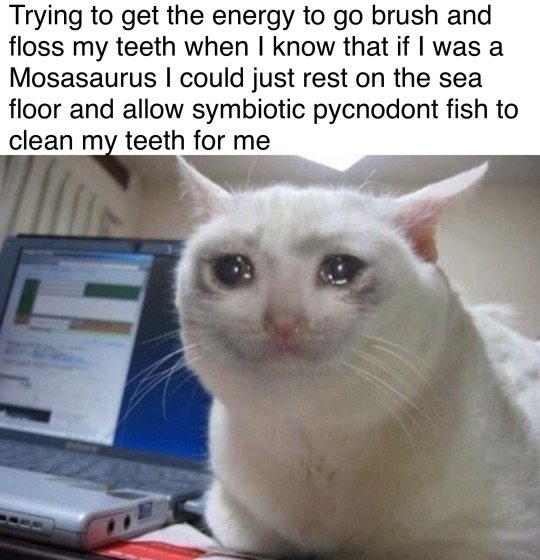
It just seems like a more elegant system to me
20K notes
·
View notes
Text
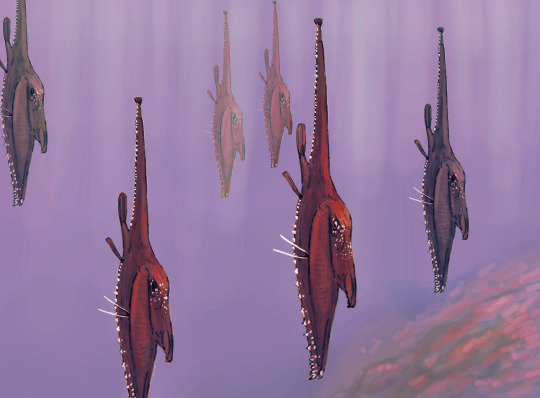
Another sketch brought to you by #paleostream
"DON'T BE AFRAID, the swarm said as it hovered closer. Barely as fish recognizable bodies moving up and down in the current.
Maraldichthys, a pycnodontiform fish and one of the strangest vertebrates the world has ever seen.
3K notes
·
View notes
Photo
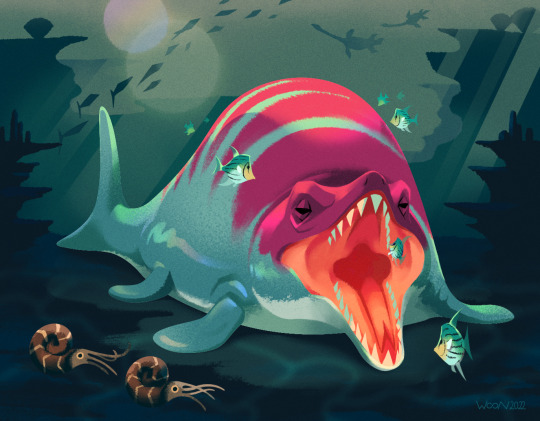
🌊 Hello Hoff 🌊
Another fan art for Prehistoric Planet
#prehistoric planet#mosasaurus#Hoffman’s Mosasaur#paleontology#paleoblr#Illustration#ammonite#pycnodont#tuarangisaurus keyesi#elasmosaur#Fanart
2K notes
·
View notes
Photo

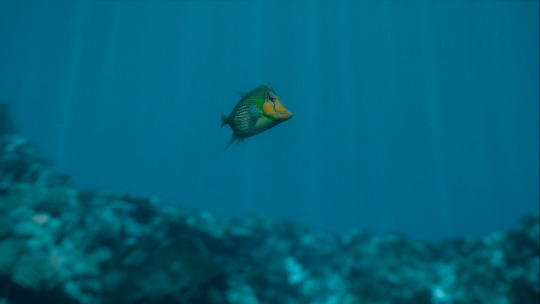


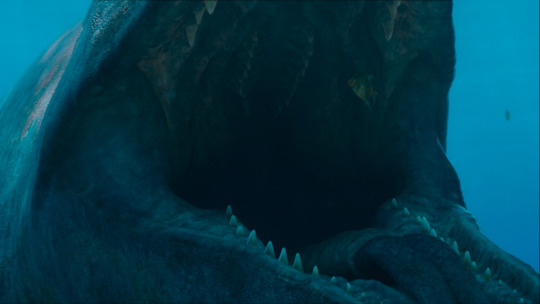



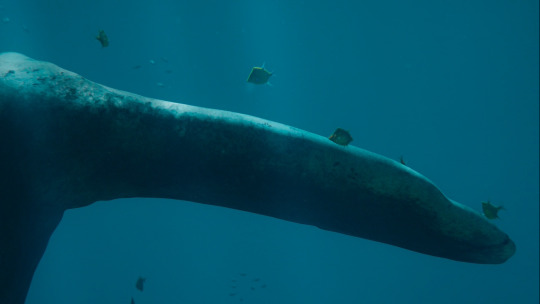
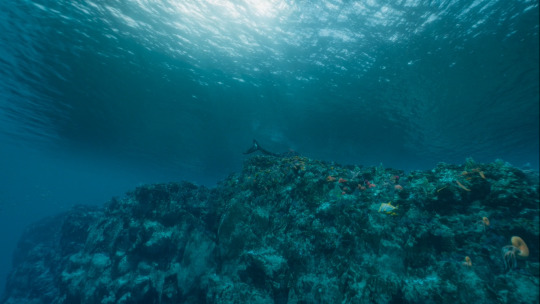
Life of our Prehistoric Planet: Pycnodontid fish.
#prehistoric planet#prehistoric planet season 1#pycnodont#pycnonotidae#fish#cretaceous period#mine#q
7 notes
·
View notes
Text
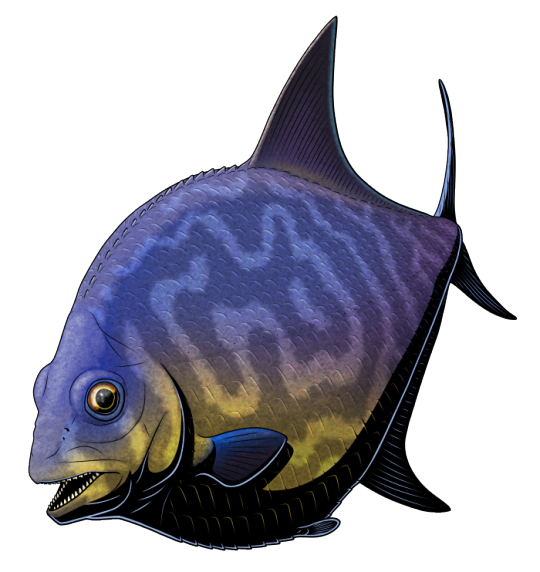
The pycnodonts were a diverse group of ray-finned fish that were found in shallow coastal waters from the late Triassic to the late Eocene (~215-37 million years ago). They usually had deep but very narrow body shapes with a disc-like appearance, convergently similar to modern reef fish like marine angelfish or butterflyfish – but some looked much weirder, with elaborate horns and spines, long snouts, or vertically-stretched bodies.
Most of them also had jaws full of round flat teeth used to crush hard-shelled prey, but some may instead have been herbivorous grazers similar to parrotfish.
And a couple of lineages even became carnivores.
Serrasalmimus secans lived in what is now Morocco during the late Paleocene, about 59 million years ago. Although only known from its jaws, the size of the fossil material suggests it was fairly large for a pycnodont, possibly around 80cm long (~2'8").
It had sharp flesh-cutting teeth similar to those of modern piranha, but with a surprising evolutionary twist. Unlike any other known ray-finned fish, Serrasalmimus' teeth were true shearing carnassials anchored into bony sockets, with new replacement teeth forming directly below each current tooth – a very specific arrangement of features previously only known in mammals.
This is an especially remarkable example of convergent evolution because on land placental carnivorans were developing their own carnassials at the same time, just a few million years after the K-Pg mass extinction. Both mammals and pycnodonts were simultaneously taking advantage of the vacant predatory roles in their respective ecosystems, and ended up with incredibly similar tooth adaptations as a result.
———
Nix Illustration | Tumblr | Twitter | Patreon
#science illustration#paleontology#paleoart#palaeoblr#serrasalmimus#serrasalmimidae#pycnodonts#pycnodontiformes#neopterygii#actinopterygii#fish#art#convergent evolution#swim like a butterflyfish bite like a mammal
242 notes
·
View notes
Text

so lately I’ve been watching Prehistoric Planet to cope
#prehistoric planet#mosasaurus#pycnodont fish#david attenborough#my beloved#you make this life just a tad less sucky#pride month#fckyeah#buckle up boyos (gender neutral)#I actually don’t mind the rainbow logos#also I can and will abuse this meme format
31 notes
·
View notes
Photo
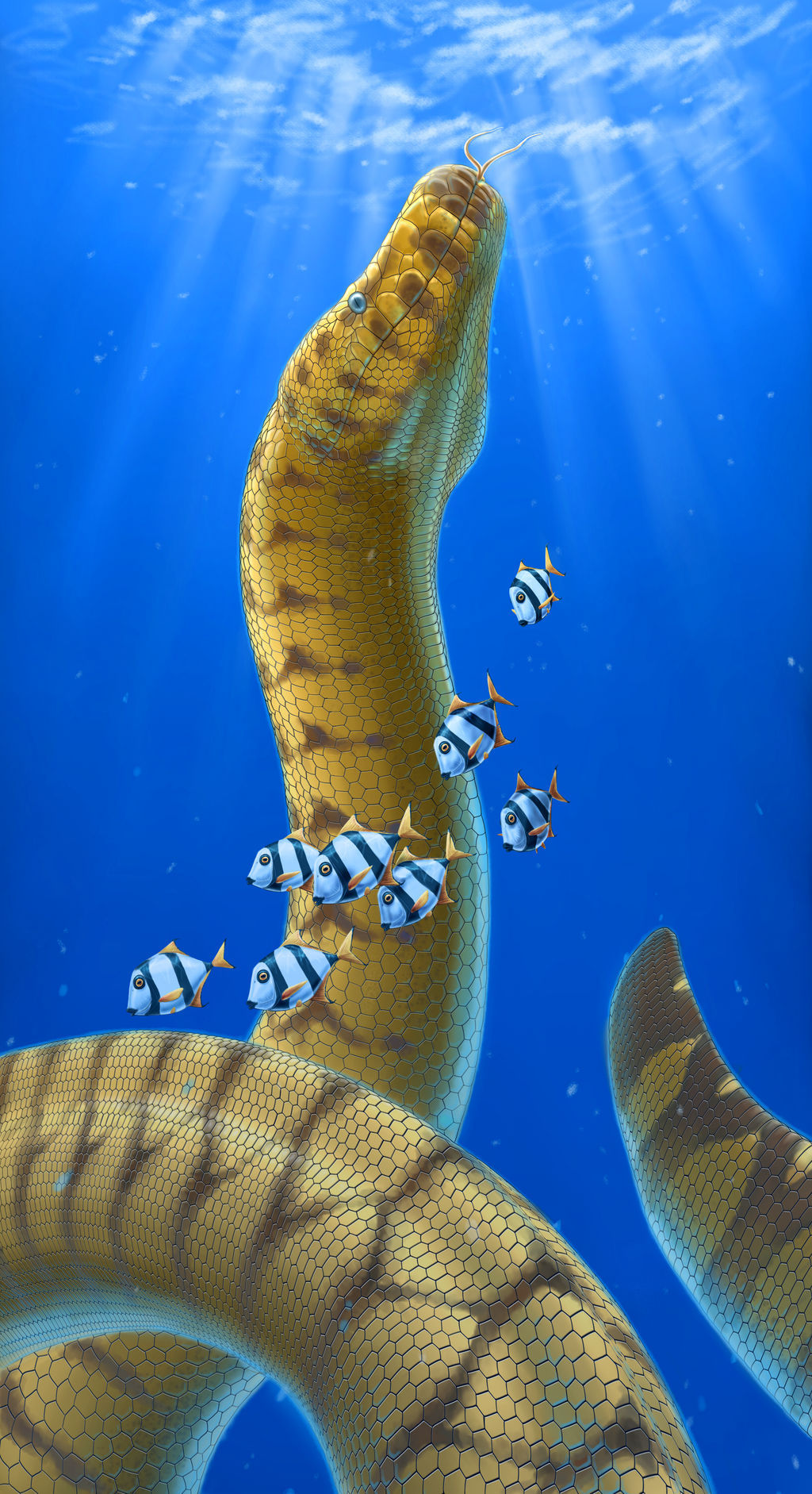
Portrait of Palaeophis colossaeus, the giant Eocene sea snake from Mali, surrounded by Pycnodont fish while swimming to the surface to drink freshly fallen rainwater
It took forever to finish but here it is ! I tried to emulate the very weird (but beautiful!!) bony projections of the vertebrae, called pterapophysis and characteristic features of the Palaeophiidae family, on the neck pattern.
912 notes
·
View notes
Text
Crelog #2
(for optimal viewing, please use a computer and blog address ^^)
This is the second Novinitum D crelog! (a.k.a. creator log. I know, very creative). These are basically like devlogs but for my specevo and worldbuilding projects. Entries where it's me updating yall on the behind-the-scenes stuff and also asking for feedback on occasion, maybe even a poll, we'll see.
It's been a while! Happy 2024! In this entry I'll be discussing some major changes about the planet + a tentative list of seeding taxa! It's very brief but I think I owe it to the very small handful of people who've shown interest in this project.
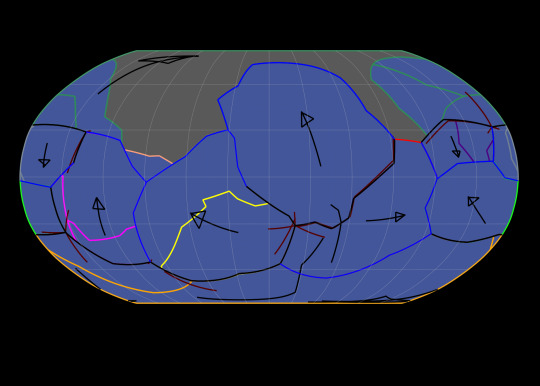
sneak peak into what this crelog features
Previous crelog [#1] <- [#2] -> Next crelog [#3]
🗒️Crelogs🗒️
~~~~~🌎🌍🌏~~~~~

the state of the world map at 0 MY (the massive blank space is part of a plate which is too big for gplates to render)
The eagle-eyed amongst you will notice that not only is this an entirely different map, but that I'm starting from an entirely different method. Instead of starting with a super continent which splits apart - like in Worldbuilding Pasta's method (link to their blog here) - I've started from the oceanic plates first, essentially starting the world from scratch. The map at 50 MY will be seen when I reveal the name of the first time period.
~~~~~🐟🐟🐟~~~~~
This list is very tentative but most likely will stay the same:
Animals:
Operculaurisichthys
made up fully pelagic Grimothea species
reef building oysters
scallops
copepods
made up Argyroneta species
clam shrimp of marine and freshwater varieties
made up thalattosuchian genus
made up starfish genus
made up Ptychoceras species
made up Squalus species
made up lanternfish species
made up pycnodont species
Plants:
Zostera marina
indeterminate algae
Valonia ventricosa
indeterminate phytoplankton
Fungi:
marine lichens (I know these aren't true fungi but for simplicity's sake they're here)
That's all for now! There should be more coming soon since progress has been incredibly quick since the change in plate tectonic method
#NovinitumDCrelog#worldbuilding#spec evo#speculative biology#speculative zoology#GPlates#plate tectonics
8 notes
·
View notes
Text
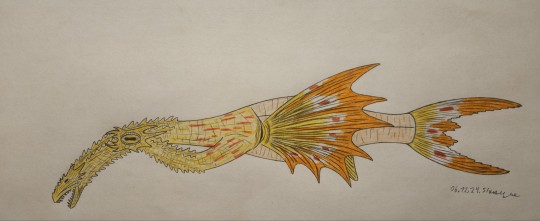
Celestial stormfish is a very rare species of pycnodont found mainly in shallow waters. It is a bottom feeder , eating anything it can find on the floor of ocean. They may look awkward while feeding but are actually quite specialized in that. Huge long head has a lot of electroreceptors which help to find prey and avoid predators , it also has a strong tongue that helps to crush prey before it gets to stomach. Celestial stormfish gain their name from prefering to hunt during storms , for different reasons.

7 notes
·
View notes
Note
Frankly, I don't think ranching large sea creatures should be a thing. The ranges they would need for food & comfort would be ENORMOUS. Keeping large marine vertebrates like plesiosaurs, ichthyosaurs, and mosasaurs would be like keeping dolphins: stressful for the animal to the point of poor health and thus rather cruel. I think we should just be able to make friends with them so they'd stick around near the ranch and help out when prompted, not keep them confined on the ranch itself. (If we can ranch something small like pycnodont fish, trilobites, or ammonites, that'd be okay because they'd be more comfortable with smaller habitats so long as they had enough space. Maybe throw in an anomalocarid or a sea scorpion or two, it's not like the ocean's ever been short on strange animals you could fit into an aquarium.)
VERY interesting thing to consider here- we definitely don't want any of the befriended dinosaurs to have a captive/cruelty insinuation when you befriend them! I've copies this suggestion over for our devs!
18 notes
·
View notes
Text
Now that Prehistoric Planet is over, I'll compile a list of ideas I'd like to see if we ever get a season 2. This is going to assume we stick to the Maastrichtian, if we open it up to the whole Mesozoic we'll be here all day.
More marine reptile diversity! Would love to see how varied plesiosaurs were, especially Aristonectines, and also just how many niches mosasaurs occupied, including potentially stranger ones like Xenodens. Same for any other reptiles like turtles for that matter.
Honestly, more marine life in general. It wasn't just big reptiles. We saw ammonites briefly, how about more cephalopods? Different fish, we saw pycnodonts briefly, sharks could be nice too? Hell, give us hesperornithines, actual sea dinosaurs.
On the topic of birds, it's wild we didn't get many birds, and none that really got any focus. Already some interesting birds at this time, like various enantiornithines such as avisaurs, weird island birds in Europe, and even neornithines.
On the note of Europe... I'd love to see more Hateg Island. We didn't get to see any of the creatures in-depth, so exploring how islands shape the fauna there would be great. There were even crocodyliformes there! Also, Hatzegopteryx hunting bigger prey.
If we're talking islands, revisiting Madagascar would also be great. Another ecosystem that is quite varied. It may not have dwarf sauropods, but it has many dinosaurs beyond Masiakasaurus, as well as a host of unusual crocodyliformes.
Crocodyliformes in general. We somehow got NONE. Not even baurusuchids, not to mention all the other varied notosuchians out there. There's even the marine dyrosaurs, and close relatives of modern true crocodilians. Gimme weird mammal crocs and terrestrial dino hunter crocs!
Honestly? Mammals also got super snubbed. Mammals were way more diverse than we give them credit for in the Mesozoic, and this would be a perfect place to show it. Gondwanatheres, metatherians, multituberculates, even placentals like possible primate Purgatorius.
In terms of locations, I'd love to see India, especially to see the animals there living in close proximity to the Deccan Traps. Many dinosaurs there too, and even the snake Sanajeh.
For locations we already saw to explore further in depth, maybe also some more Zealandia, Antarctica and South America? Especially for looks at their ecosystems if we have the data for it.
Of course who knows if we'll even get a Season 2, but if we do, hopefully some of these come to pass.
97 notes
·
View notes
Text
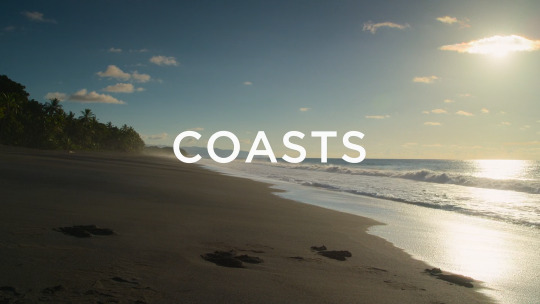

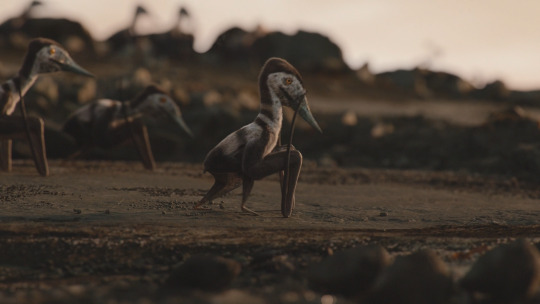




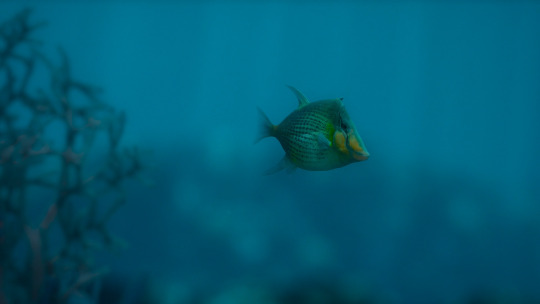
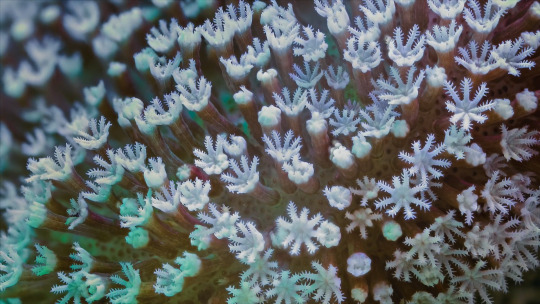
favourite shots from prehistoric planet - episode one
Part 2/2
Scaphitid ammonite | Alcione
Tuarangisaurus | Scaphitid ammonite
Kaikaifilu | Coral
Pycnodont fish | Coral
If anyone can identify the coral I will be eternally grateful.
#palaeoblr#prehistoric#dinosaur#dinosaurs#palaeontology#prehistoric planet#prehistoric planet show#dinosaur documentary#feathered dinosaurs#coral#ammonite fossil#scaphitid ammonite#ammonite#coral species#cretaceous#cretaceous coral#Kaikailifu#mosasaurus#tuarangisaurus#fish#paleobiology#marine biology#corals#paleomedia#paleo art#paleoblr#pterosaur#pterosaurs#alcione
44 notes
·
View notes
Text



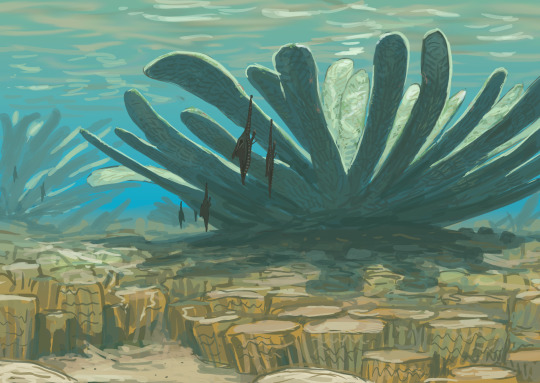
Results from the #paleostream Congopycnodus, Necrolemur (a #MonkeyCruise piece!), Elephas hysudricus and Chondrodonta (and very large bivalve)
#paleoart#sciart#pycnodont#lemur#monkeycruise#elephant#bivalve#primate#cretaceous#paleostream#photo#fossil fish#jurassic#palaeoblr
612 notes
·
View notes
Photo

Being around 56 feet long, being big enough to dwarf even the mighty T. Rex, Mosasaurus hoffmani (Hoffman’s lizard of the Meuse River) is the largest predator to live on the face of the planet during the Late Cretaceous. This gigantic relative to the komodo dragon of today lived entirely in the ocean, serving as a powerful predator that can attack and devour any animal that it so chooses. However, despite its fierce reputation, this beast has a gentle side; Traveling to coral reefs, it can get scrubbed up from a cleaning station. Shrimps, pycnodont fish, and other small animals pick at the lizard’s shedding skin, ridding it of any dead bits of skin, parasites, and other such dermal issues.
2 notes
·
View notes
Text
If I have one single nitpick with the first ep, it’s that a lot of the marine life is live action — it’s not quite a real Maastrichtian sea.
And yet, they bothered animating little pycnodont fish as cleaners!! What a lovely touch.
The mosasaur at the cleaning rock and its ensuing tussle with a rival is fabulous, and I was legitimately startled by the sudden attack — perhaps because I was busy squealing at how great it was to see the mosasaur lolling about on the reef, and being thrilled at the point being made that mosasaurs are literally big lizards (they even gave them gummy mouths like monitors!!). The combat sequence feels REAL, and Charles Sternberg would be thrilled at the mosasaurs ramming each other with their heads.
3 notes
·
View notes
Text

Progress Pride Flag + Pycnodont fish sketch Personal use with credit is welcome. ^^
#QueerPaleo#FossilPride#PrideInNaturalHistory#LGBTQIAFossils#PrehistoricPride#PaleoArtLove#QueerScience#PaleoLGBT#QueerPaleontology#DinoRainbow#NaturalHistoryPride#QueerScientist#queer#stem#prideinSTEM#queerinstem#sciart#scienceart#scienceillustration#queerinscience#LGBTinSTEM#palaeontology#paleontology#queerillustration#Pycnodontfish#paleofish#paleofishart
1 note
·
View note